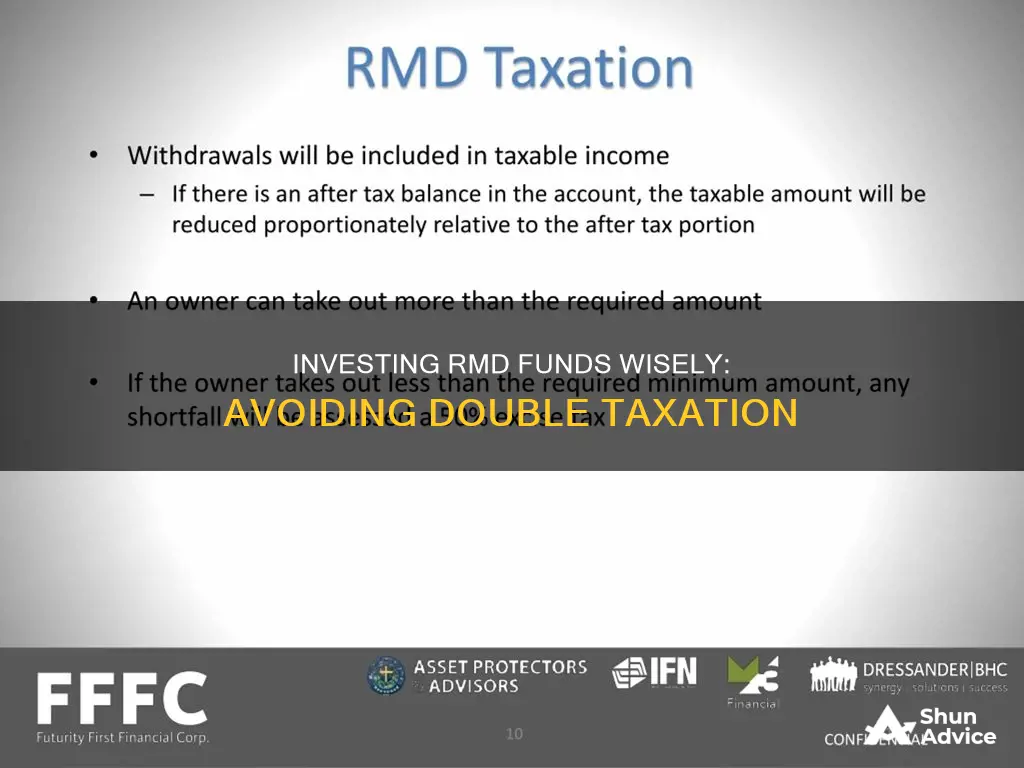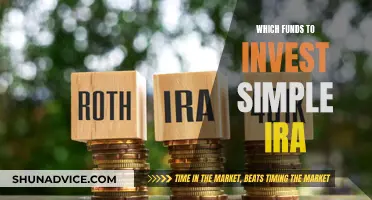
Once you reach a certain age, the Internal Revenue Service (IRS) requires you to take a minimum annual distribution from your retirement accounts. These are called required minimum distributions (RMDs). While you can spend your RMDs on living expenses, you may not need to, and you might want to avoid double taxation. If you don't need to use your RMDs for living expenses, you can reinvest them in a taxable investment account or redirect them towards other tax-advantaged uses, such as 529 education plans and qualified charities.
| Characteristics | Values |
|---|---|
| Age requirement for RMD | 72 or 73, depending on birth year |
| First RMD deadline | April 1st the year after turning 72 or 73 |
| Subsequent RMD deadlines | December 31st each year |
| RMD calculation | Prior calendar year-end balance divided by life expectancy number provided by IRS |
| RMD reinvestment options | Taxable investment accounts, 529 education plans, qualified charities, stocks, bonds, mutual funds, ETFs, etc. |
| RMD spending options | Living expenses, debt repayment, high-yield savings accounts, certificates of deposit (CDs), travel, discretionary purchases |
What You'll Learn

Reinvesting in a taxable brokerage account
There are a few things to keep in mind when reinvesting your RMD in a taxable brokerage account. First, you will need to pay taxes on the RMD amount as it is considered ordinary income. Make sure you set aside money to pay the estimated taxes throughout the year. Second, be aware of the investment vehicle you choose as it will impact the taxation of your earnings. For example, profits from the sale of stock are taxed as capital gains, while owners of mutual funds typically pay taxes on earnings and dividends.
Another option to consider is to use your RMD to contribute to a 529 college savings plan. This allows your investment to grow tax-deferred, and withdrawals for qualifying education expenses are tax-free. You can also automate your RMDs and 529 contributions so that each time your RMD is distributed, a contribution is made to the 529 account.
Additionally, you may be able to contribute your RMD to a Roth IRA as long as you have earned income equal to or greater than the RMD amount. However, it is important to note that you cannot convert RMDs directly into a Roth IRA, and there are income limits and contribution rules for Roth IRAs that you need to consider. Consult a tax professional to determine if this is the best option for you.
Best Index Funds: Where to Invest Your Money
You may want to see also

Donating to a qualified charity
The key benefit of a QCD is that it reduces your taxable income. Once you reach the age of 73, the QCD amount counts towards your RMD for the year, with an annual maximum of $100,000 per individual or $200,000 for a married couple filing jointly. This means that if you're donating to charity, using your RMD through a QCD can be more tax-efficient than taking the distribution and then donating it, as the latter would increase your adjusted gross income.
Additionally, QCDs do not count against the limits on deductions for charitable contributions. This makes them advantageous for certain high-income earners, especially those who claim the standard deduction and would not benefit from itemizing charitable donations of cash proceeds from an RMD.
When considering a QCD, it's important to ensure that the charity you choose is eligible. Not all charities qualify, and there are specific rules that must be followed. For example, the charity cannot be a private foundation, a donor-led organisation, or a supporting organisation that supports other charities.
It's also crucial to consult a tax professional before making a QCD, as they can be tricky. By planning ahead and understanding the rules, you can effectively use your RMD funds for charitable giving while minimising your tax burden.
How Investments Increase Loanable Funds for Businesses
You may want to see also

Funding a 529 college savings plan
Tax Benefits
The earnings in a 529 plan grow tax-free at the federal and state level. While you do have to pay income tax on the RMD itself, the money you invest in the 529 plan will grow tax-deferred. This means that you can avoid paying taxes on the same money twice. Additionally, if the money is used for qualified education expenses, the entire amount, including earnings, can be withdrawn tax-free. Some states also offer tax benefits, such as tax deductions or credits for contributions to a 529 plan.
Financial Aid Qualification
When determining financial need for federal aid, the Expected Family Contribution (EFC) considers 20% of a student's assets, 5.64% of a parent's assets, and 0% of a grandparent's assets. By setting up a 529 account in the grandparent's name with the grandchild as the beneficiary, you can keep the contributions classified as the grandparent's assets, increasing the grandchild's eligibility for federal aid.
Flexibility
529 plans offer flexibility if circumstances change. For example, if the intended beneficiary receives a full scholarship or no longer needs the funds, you can change the beneficiary to another family member and retain the tax advantages of the plan. Additionally, if you decide to pursue education during retirement, you can even name yourself as the beneficiary of your 529 account.
Completed Gifts and Control
Deposits into a 529 plan are considered completed gifts and are not included in the estate of the account owner. This means that the assets are protected from estate taxes. At the same time, the account owner retains control of the account at all times and can revoke the assets back to themselves if needed. However, revoking the account may trigger taxes and penalties on earnings.
Large Maximum Contributions and Small Minimums
529 plans typically have large maximum contribution limits, ranging from $300,000 to $500,000. They also usually have small minimum contribution requirements, or none at all. This flexibility allows you to contribute according to your RMD distribution amount.
UTI Midcap Fund: A Smart Investment Strategy
You may want to see also

Contributing to a Roth IRA
If you're looking to invest your RMD funds without incurring double taxation, one option to consider is contributing to a Roth IRA. Here are some key things to know about this strategy:
- Age Requirements: The rules around RMD age requirements have changed over the years. If you were born in 1950 or earlier, your RMD start date is at age 72. For those born between 1951 and 1959, the RMD start date is at age 73. If you were born in 1960 or after, your RMD start date is at age 75. It's important to note that these age requirements are for traditional retirement accounts, and Roth IRAs do not have the same RMD rules.
- Tax Advantages: Roth IRAs offer tax advantages that can help you avoid double taxation. While you will have to pay taxes on the amount you withdraw from a traditional IRA, Roth IRAs are different. With a Roth IRA, you pay taxes on the money you contribute, and then your investments grow tax-free. This means that once you reach the age where RMDs are required, you won't be taxed again on those distributions.
- No RMD Requirements: One of the most significant benefits of a Roth IRA is that it does not have any RMD requirements during the original owner's lifetime. This means that you are not required to withdraw funds from your Roth IRA, regardless of your age. This can be especially advantageous if you don't need the money yet and want to let it continue growing tax-free.
- Contribution Limits: It's important to note that there are contribution limits for Roth IRAs. The contribution limit for 2024 is the lesser of $7,000 or your total compensation for the year. Additionally, your ability to contribute to a Roth IRA may be limited if you have a high income. There are income limits that determine your eligibility to contribute, and these limits are adjusted annually.
- Recharacterization: If you have already contributed to a traditional IRA, you may be able to recharacterize those contributions as Roth contributions. This means that you can transfer the funds from your traditional IRA to a Roth IRA, effectively converting the tax treatment of those contributions. However, you will need to pay taxes on the amount converted.
- Five-Year Rule: It's important to be aware of the five-year rule when it comes to Roth IRAs. To take tax-free distributions from your Roth IRA, it must be at least five years old, and you must be over the age of 59.5. If you withdraw funds before meeting these requirements, you may have to pay taxes and penalties on the earnings portion of your distribution.
- Spousal Considerations: If you are married, you and your spouse can each have your own Roth IRAs, effectively doubling the amount you can contribute annually. Additionally, if your spouse has earned income but does not work outside the home, they can still contribute to a spousal Roth IRA, as long as certain requirements are met.
- Beneficiary Designations: When you pass away, your Roth IRA can be passed on to your beneficiaries. They will not owe any taxes on the distributions they take from the inherited Roth IRA, as long as the account has been open for at least five years. This can be a great way to leave a tax-free inheritance to your loved ones.
By contributing to a Roth IRA, you can take advantage of its tax benefits and avoid double taxation on your RMD funds. Remember to consider your personal financial situation and consult with a financial advisor or tax professional before making any decisions.
Fat Tail Funds: Strategies for Investing in Uncertain Markets
You may want to see also

Spending on living expenses
Spending your RMD on living expenses is a common choice for many households, as it is the general reason people save for retirement in the first place. Depending on your budget, savings, and other income, your RMD could be a critical source of funds.
You can use your RMD to pay off a home equity line of credit, a large medical bill, or a student loan, which may save you money on interest in the long run. Eliminating these monthly payments can free up cash for living expenses, travel, or anything else you value.
If you don't need the funds for necessities, you can put the money back to work for you by either saving it in a high-yield savings account or a certificate of deposit (CD). Cash in the bank is FDIC-insured, making it one of the safest places to put your money. Consider using your withdrawal to create an emergency fund or rainy-day fund if you don't already have one.
If you plan to use RMDs to pay for current living expenses, consider using a cash management account to pay your expenses. It often makes sense to have a budget in retirement. Going through the budgeting process can help you estimate living expenses, manage your cash flow, and determine if you'll need to use your RMDs to fund your retirement lifestyle.
Invest in Your Child's Future: Index Funds for College
You may want to see also
Frequently asked questions
RMD stands for "required minimum distribution". Once you turn 72 or 73, depending on your birth year, you must withdraw a specified minimum amount from your account yearly.
You can invest your RMDs in a taxable brokerage account, a 529 college savings plan, a Roth IRA, or donate them to a qualified charity.
To avoid double taxation, you can invest your RMDs in a Roth IRA or donate them to a qualified charity. With a Roth IRA, you pay taxes on the amount you contribute, but withdrawals in retirement are tax-free. Qualified charitable distributions (QCDs) are not included in your gross income and do not count against the limits on deductions for charitable contributions.
Yes, you can use your RMDs to pay for current living expenses or put them in a high-yield savings account or certificate of deposit (CD).







